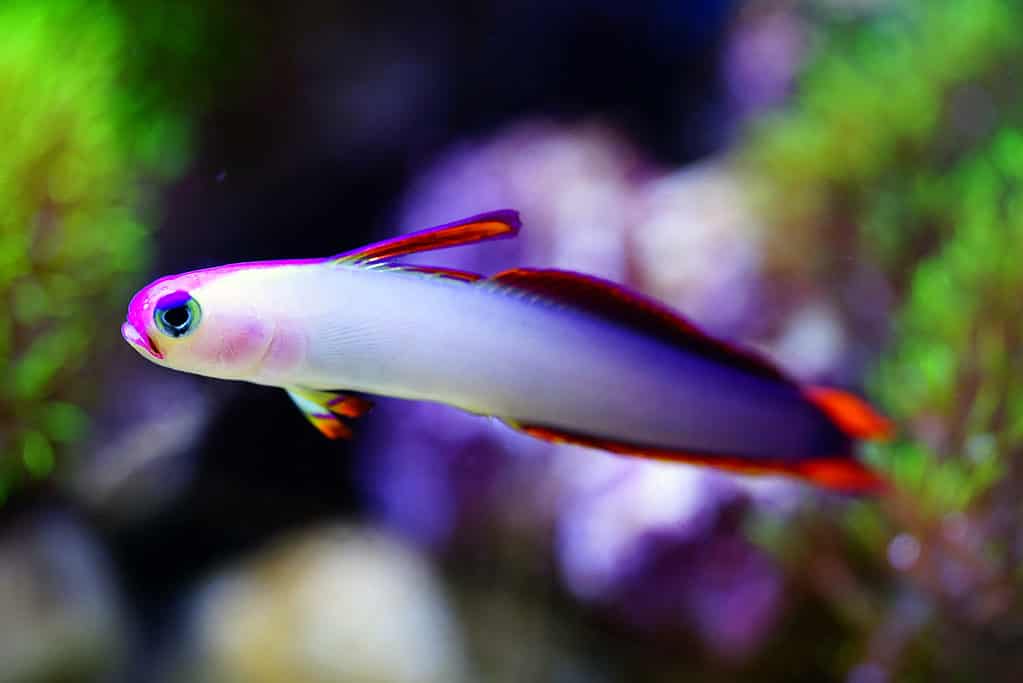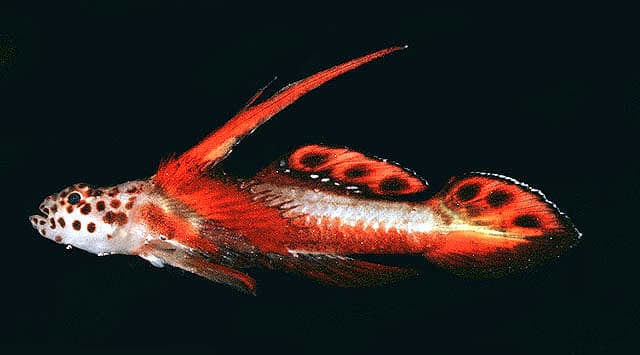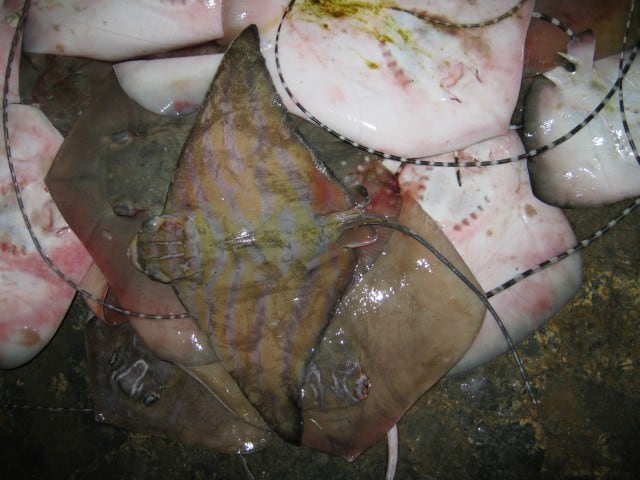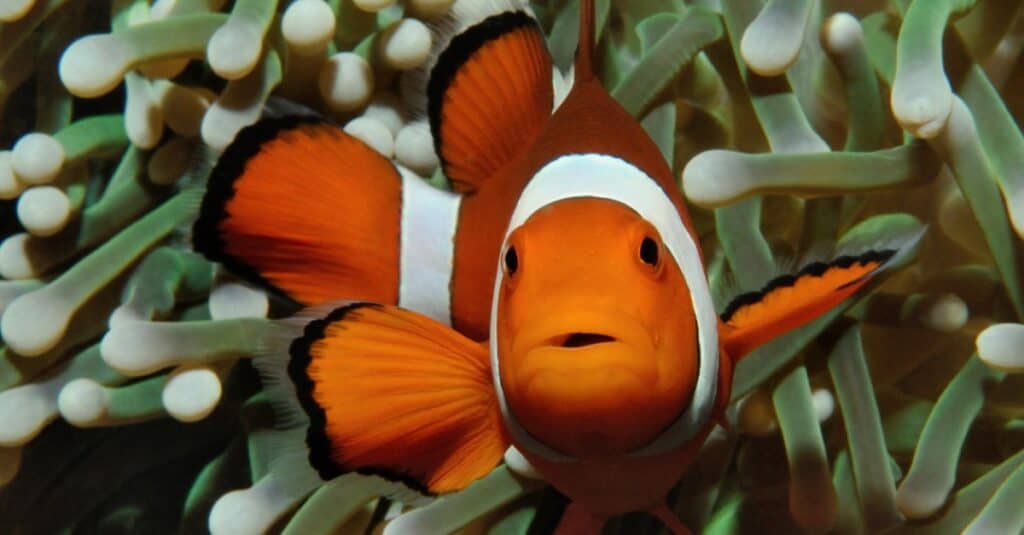The Philippines is an archipelago with over 7,000 islands showcasing an astounding array of wildlife. This includes thousands of species of marine and freshwater fish. The country’s natural wonders are so incredible that it is home to several UNESCO World Heritage Sites, including the Tubbataha Reefs in the Sulu Sea. Read on to discover 8 spectacular fish found in the Philippines!
1. Elegant Firefish

One of the most spectacular fish found in the Philippines is the elegant firefish (Nemateleotris decora), a reef-associated marine species.
©Chris Cheung/Shutterstock.com
One of the most spectacular fish found in the Philippines is the elegant firefish (Nemateleotris decora), a reef-associated marine species. However, it also swims in deep coastal areas as well as outer reefs near drop-offs. This gorgeous fish is monogamous, often occurring in pairs at depths between 82 to 230 feet. When startled, it darts into a hole to avoid predators.
The elegant firefish is small, growing to a maximum length of 3.54 inches. Its white or yellow body transitions into a violet head and vibrantly purple, pink, and red fins. Because of its purple coloration, it also goes by the name “purple firefish.”
2. Knifetooth Sawfish

The knifetooth sawfish grows up to 15.42 feet in length. Its dorsal region is greyish in color while its underside is pale.
©Morphart Creation/Shutterstock.com
The second Philippine fish on our list, the knifetooth sawfish (Anoxypristis cuspidate), is more bizarre than beautiful. The species belongs to the sawfishes, which are a type of ray related to sharks. Also called the pointed sawfish, this fish sports a flat head ending in a long, saw-like snout armed with teeth. However, it has no teeth at the base of the blade.
The knifetooth sawfish grows up to 15.42 feet in length. Its dorsal region is greyish in color while its underside is pale. It prefers to cruise the waters near shore, especially river estuaries, deltas, and sandy bays.
3. Flaming Prawn Goby

Also known as the spikefin goby, its flamelike colors and flamboyant fins make it an attractive inhabitant of both reefs and tanks.
©640 × 355 pixels, file size: 39 KB, MIME type: image/jpeg – License
The flaming prawn goby (Discordipinna griessingeri) is another example of stunning Philippine marine life. Also known as the spikefin goby, its flamelike colors and flamboyant fins make it an attractive inhabitant of both reefs and tanks. In the wild, it seeks out areas with coral, rubble, and sand where it can easily hide. Its preferred depth ranges from 6.5 to 148 feet.
The flaming prawn goby is a tiny fish, only growing to about 1.18 inches in length. Its body is white with orange stripes and a brown-speckled head; its flared fins are a vibrant orange and white.
4. Banded Eagle Ray

This species haunts both marine and brackish waters, preferring to lurk near the ocean floor at depths of up to 230 feet.
©640 × 480 pixels, file size: 78 KB, MIME type: image/jpeg – License
The banded eagle ray (Aetomylaeus nichofii) is one of several species of rays around the Philippine islands. Its name comes both from the transverse bluish bands on its dorsal region and its broad, pointed “wings.” Although it has a long tail, it lacks a stinger. This species haunts both marine and brackish waters, preferring to lurk near the ocean floor at depths of up to 230 feet.
The banded eagle ray grows up to 2.13 feet in length. Besides its pale blue bands, its dorsal region is brownish-grey without dark spots while its ventral region is whitish.
5. Whale Shark

Whale shark swimming with pilot fish.
©Tee Wong/Shutterstock.com
The biggest fish found in the Philippines – and in the world – is the whale shark (Rhincodon typus). This shark (not whale) occurs around the world in tropical and warm temperate seas with the exception of the Mediterranean. Despite its unbelievable mass, it is a filter-feeder and therefore not dangerous to humans. Its back is grey, bluish, blue-grey, or green-brown with white or yellow spots; its underside is yellowish or white.
The biggest whale shark on record measured 61.7 feet in length, though some unconfirmed individuals may have been even longer. The maximum published weight for the species is 34 tons.
6. Ribbon Eel

The ribbon eel can live up to 20 years.
©randi_ang/Shutterstock.com
One of the most spectacular fish found in the Philippines is the ribbon eel or ribbon moray (Rhinomuraena quaesita). Its alternate name, the leaf-nosed moray eel, references the two leaf-like protrusions on the end of its snout. This remarkable species swims by undulating its elongated, ribbonlike body. It inhabits reefs at depths of up to 220 feet, often hiding in sand or rubble.
The ribbon eel grows to lengths of up to 4.26 feet. Ribbon eels are protandrous hermaphrodites, meaning the males have the capacity to reverse sex to become females. As juveniles, these fish are black with yellow fins. When they grow to become adult males, their bodies change from black to a striking blue. After transitioning to females, their bodies turn yellow.
7. Ocellaris Clownfish

Male clownfish take the primary role in nursing eggs.
©Oksana Golubeva/Shutterstock.com
The ocellaris clownfish or clown anemonefish (Amphiprion ocellaris) is one of the most famous clownfish species. These marine fish are easily recognizable around the world with their three white stripes encircling their distinct bright orange bodies. This reef-associated species swims at shallow depths above 50 feet, making its home among the venomous tentacles of sea anemones.
Much like the ribbon eel, ocellaris clownfish are protandrous hermaphrodites. They are also monogamous with the males in charge of guarding and aerating the eggs. These are small fish, growing to lengths of up to 4.33 inches.
8. Beautiful Dartfish
The last Philippine fish on our list is the beautiful dartfish (Ptereleotris kallista), a species that certainly deserves its appellation. The name Kallista comes from a Greek word meaning “most beautiful.” This marine fish has a long, silvery body that shimmers like a rainbow in the light, crowned with two bluish dorsal fins. The first of these fins is almost twice the height of the second but not nearly as long. The caudal fin is asymmetrically rounded.
The beautiful dartfish grows as long as 2.75 inches. It prefers to linger around reefs instead of venturing into the open ocean.
Conclusion
The Philippines is home to an incredible variety of other land and aquatic species. Check out this article to read more about wildlife in the Philippines.
Up Next:
- Discover 7 Spectacular Fish Found in the Bahamas
- Discover 7 Spectacular Fish Found in Cambodia
- Discover 8 Spectacular Fish Found in the Arctic
The photo featured at the top of this post is © weera bunnak/Shutterstock.com
FAQs (Frequently Asked Questions)
How many islands are a part of the Phillippines?
The Philippines is an archipelago with over 7,000 islands showcasing an astounding array of wildlife. This includes thousands of species of marine and freshwater fish. The country’s natural wonders are so incredible that it is home to several UNESCO World Heritage Sites, including the Tubbataha Reefs in the Sulu Sea.
What is special about the beautiful dartfish?
The name Kallista comes from a Greek word meaning “most beautiful.” This marine fish has a long, silvery body that shimmers like a rainbow in the light, crowned with two bluish dorsal fins. The first of these fins is almost twice the height of the second but not nearly as long. The caudal fin is asymmetrically rounded.
Thank you for reading! Have some feedback for us? Contact the AZ Animals editorial team.






